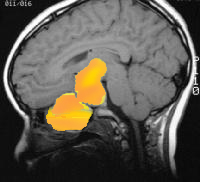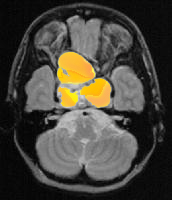About Rathke's Cleft Cyst

Rathke's cleft cysts (RCCs) lesions located in the sellar and para-sellar space at the base of the brain. They are thought to originate from remnants of Rathke's pouch, which is an embryonic structure that comes from the roof of the mouth and forms the anterior pituitary gland.
Symptoms
Rathke's cleft cysts often produce no symptoms and are incidental on radiographic examiniations. Symptomatic cysts tend to be large and cause symptoms from compression of the pituitary gland, pituitary stalk, optic chiasm, or hypothalamus.
Most patients will complain of headaches and visual problems such as reduced visual acuity, loss of part of the visual field, or loss of bilateral peripheral visual fields ("bitemporal hemianopsia"). Many patients will present with endocrinological dysfunctions due to involvement of the pituitary gland or hypothalamus. Such symptoms include diabetes insipidus, amenorrhea, galactorrhea, or panhypopituitarism. A few patients can present with seizures.
Diagnosis

The definitive diagnosis of a Rathke cleft cyst is made by neuroimaging studies, such as CT and MRI scans of the brain. CT scan will reveal the degree of calcification of the tumor and involvement of the bone. MRI with and without contrast will show the full extent of the tumor and its involvement with adjacent brain.
Endocrinological studies, such as thyroid hormone, growth hormone and cortisol levels, may be useful is ruling out other types of tumors.
Opthalmological examinations, especially visual field testing and fundoscopic examinations, help determine the degree of visual loss.
Treatment of Rathke's Cleft Cyst
Surgery
The first step in treatment is surgery. Surgery provides tissue for diagnosis and relieves any pressure on the brain caused by the tumor. Surgery alone is usually curative if the entire tumor can be safely removed. A variety of surgical approaches (subfrontal, pterional, transphenoidal, tranventricular) may be used depending on the size and location of the tumor.
Medical Management
When there are significant endocrinological disturbances caused by the tumor or surgery, specific hormones may need to be replaced, with such medicines as DDAVP, thyroid hormone, and steroids. This is usually managed with help from the medical endocrinology service.
 Rathke's cleft cysts (RCCs) lesions located in the sellar and para-sellar space at the base of the brain. They are thought to originate from remnants of Rathke's pouch, which is an embryonic structure that comes from the roof of the mouth and forms the anterior pituitary gland.
Rathke's cleft cysts (RCCs) lesions located in the sellar and para-sellar space at the base of the brain. They are thought to originate from remnants of Rathke's pouch, which is an embryonic structure that comes from the roof of the mouth and forms the anterior pituitary gland.
 The definitive diagnosis of a Rathke cleft cyst is made by neuroimaging studies, such as CT and MRI scans of the brain. CT scan will reveal the degree of calcification of the tumor and involvement of the bone. MRI with and without contrast will show the full extent of the tumor and its involvement with adjacent brain.
Endocrinological studies, such as thyroid hormone, growth hormone and cortisol levels, may be useful is ruling out other types of tumors.
Opthalmological examinations, especially visual field testing and fundoscopic examinations, help determine the degree of visual loss.
The definitive diagnosis of a Rathke cleft cyst is made by neuroimaging studies, such as CT and MRI scans of the brain. CT scan will reveal the degree of calcification of the tumor and involvement of the bone. MRI with and without contrast will show the full extent of the tumor and its involvement with adjacent brain.
Endocrinological studies, such as thyroid hormone, growth hormone and cortisol levels, may be useful is ruling out other types of tumors.
Opthalmological examinations, especially visual field testing and fundoscopic examinations, help determine the degree of visual loss.